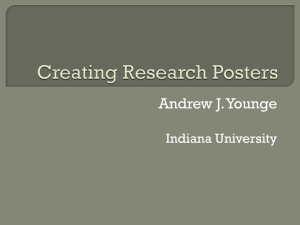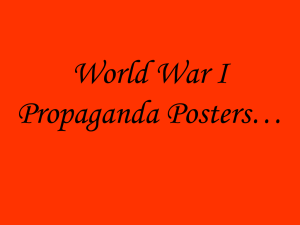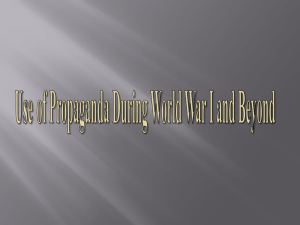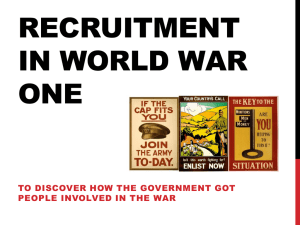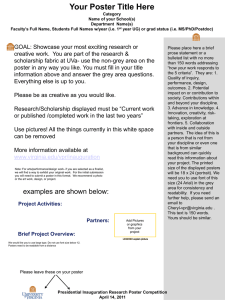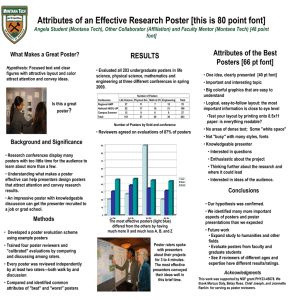10.7 - Communist Propaganda
advertisement
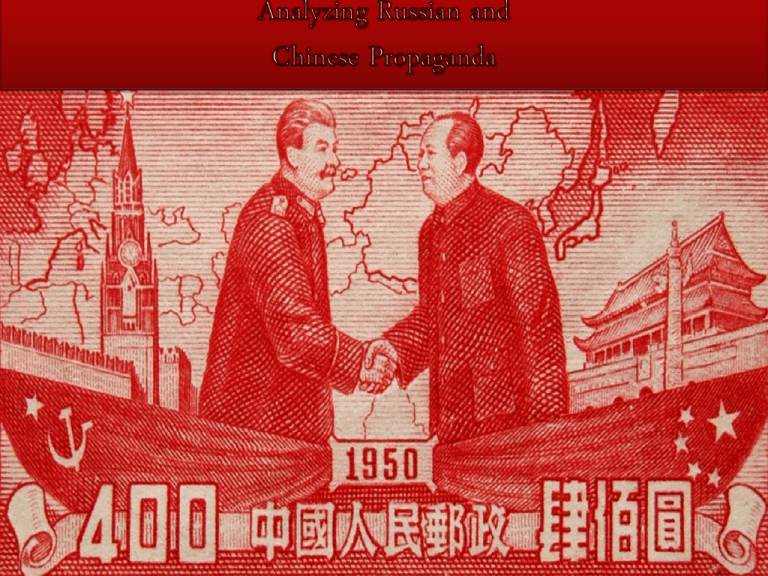
State Standards 10.7 Students analyze the rise of totalitarian governments after World War I. – Understand the causes and consequences of the Russian Revolution, including Lenin’s use of totalitarian means to seize and maintain control (e.g., the Gulag). – Trace Stalin’s rise to power in the Soviet Union and the connection between economic policies, political policies, the absence of a free press, and systematic violations of human rights (e.g., the Terror Famine in Ukraine). – Analyze the rise, aggression, and human costs of totalitarian regimes (Fascist and Communist) in Germany, Italy, and the Soviet Union, noting especially their common and dissimilar traits. 10.9 Students analyze the international developments in the post–World War II world – Analyze the Chinese Civil War, the rise of Mao Tse-tung, and the subsequent political and economic upheavals in China (e.g., the Great Leap Forward, the Cultural Revolution, and the Tiananmen Square uprising). Common Core CCSS.ELA-Literacy.RH.9-10.2 Determine the central ideas or information of a primary or secondary source; provide an accurate summary of how key events or ideas develop over the course of the text. CCSS.ELA-Literacy.RH.9-10.6 Compare the point of view of two or more authors for how they treat the same or similar topics, including which details they include and emphasize in their respective accounts. CCSS.ELA-Literacy.RH.9-10.9 Compare and contrast treatments of the same topic in several primary and secondary sources. Compare the outcomes of TWO of the following 20th century revolutions: Russian Chinese Mexican Analyze each propaganda poster with your neighbor Discuss “Discussion Questions” Record Answers to “Critical Thinking Questions” in margins of student handout Critical Thinking Questions A. What might have motivated the Chinese and Russian leadership to create these propaganda posters? B. What strategies did they employ to achieve these goals? C. How do these posters support what we already know about Russia and China in the 20th Century? E Discussion Questions Who is at the “center” of each image? Who are they surrounded by? Describe these people. (look closely at how they’re dressed… what does this represent?) Critical Thinking Questions A. What might have motivated the Chinese and Russian leadership to create these propaganda posters? B. What strategies did they employ to achieve these goals? C. How do these posters support what we already know about Russia and China in the 20th Century? 1 Discussion Questions Who is at the “center” of each image? Describe the people who surround them. Describe the setting of the images. Critical Thinking Questions A. What might have motivated the Chinese and Russian leadership to create these propaganda posters? B. What strategies did they employ to achieve these goals? C. How do these posters support what we already know about Russia and China in the 20th Century? 2 Collectivization Leads to Abundance Feast on a Collective Farm Discussion Questions Describe the peasants in these images. What else do you see? Based on the banners & posters in the background, who/what is responsible for this “abundance”? What does collectivization mean? Do you think these posters offer accurate depictions of the effects of collectivization? Critical Thinking Questions A. What might have motivated the Chinese and Russian leadership to create these propaganda posters? B. What strategies did they employ to achieve these goals? C. How do these posters support what we already know about Russia and China in the 20th Century? 3 Discussion Questions Describe the background of each poster. What are the men doing? Smelt Steel, Accelerate Socialist Construction Are you ready for the future Comrade? Critical Thinking Questions A. What might have motivated the Chinese and Russian leadership to create these propaganda posters? B. What strategies did they employ to achieve these goals? C. How do these posters support what we already know about Russia and China in the 20th Century? 4 Stop American Imperialism Discussion Questions How are Americans portrayed in each poster? What are the Americans holding? Describe the background of each poster. Who is “defending” these backgrounds? Critical Thinking Questions A. What might have motivated the Chinese and Russian leadership to create these propaganda posters? B. What strategies did they employ to achieve these goals? C. How do these posters support what we already know about Russia and China in the 20th Century? We Don’t Need Any of Your Bourgeois Luxuries 5 Discussion Questions What are these women doing? How are the women being “received” in the Chinese poster? Were these activities typical for women of the time period? Critical Thinking Questions A. What might have motivated the Chinese and Russian leadership to create these propaganda posters? B. What strategies did they employ to achieve these goals? C. How do these posters support what we already know about Russia and China in the 20th Century? 6 Discussion Questions What symbols can you identify in the bottom left corner? What is the young Chinese man in the image doing to these symbols? Destroy the Old World; Forge the New 6 Discussion Questions Who do the men on the litter represent? Who do the people carrying the litter represent? What is the relationship between the two groups? The Czar, the Church, & the Lash 6 Critical Thinking Questions A. B. C. What might have motivated the Chinese and Russian leadership to create these propaganda posters? What strategies did they employ to achieve these goals? How do these posters support what we already know about Russia and China in the 20th Century? Compare the outcomes of TWO of the following 20th century revolutions: Russian Chinese Mexican 1 Discussion Questions Who is at the “center” of each image? Describe the people who surround them. Describe the setting of the images. Critical Thinking Questions A. What might have motivated the Chinese and Russian leadership to create these propaganda posters? B. What strategies did they employ to achieve these goals? C. How do these posters support what we already know about Russia and China in the 20th Century? 2 Collectivization Leads to Abundance Feast on a Collective Farm Discussion Questions Describe the peasants in these images. What else do you see? Based on the banners & posters in the background, who/what is responsible for this “abundance”? What does collectivization mean? Do you think these posters offer accurate depictions of the effects of collectivization? Critical Thinking Questions A. What might have motivated the Chinese and Russian leadership to create these propaganda posters? B. What strategies did they employ to achieve these goals? C. How do these posters support what we already know about Russia and China in the 20th Century? 3 Discussion Questions Describe the background of each poster. What are the men doing? Smelt Steel, Accelerate Socialist Construction Are you ready for the future Comrade? Critical Thinking Questions A. What might have motivated the Chinese and Russian leadership to create these propaganda posters? B. What strategies did they employ to achieve these goals? C. How do these posters support what we already know about Russia and China in the 20th Century? 4 Stop American Imperialism Discussion Questions How are Americans portrayed in each poster? What are the Americans holding? Describe the background of each poster. Who is “defending” these backgrounds? Critical Thinking Questions A. What might have motivated the Chinese and Russian leadership to create these propaganda posters? B. What strategies did they employ to achieve these goals? C. How do these posters support what we already know about Russia and China in the 20th Century? We Don’t Need Any of Your Bourgeois Luxuries 5 Discussion Questions What are these women doing? How are the women being “received” in the Chinese poster? Were these activities typical for women of the time period? Critical Thinking Questions A. What might have motivated the Chinese and Russian leadership to create these propaganda posters? B. What strategies did they employ to achieve these goals? C. How do these posters support what we already know about Russia and China in the 20th Century? 6 Destroy the Old World; Forge the New Discussion Questions Chinese Poster – – What symbols can you identify in the bottom left corner? What is the young Chinese man in the image doing to these symbols? Russian Poster – – – Who do the men on the litter represent? Who do the people carrying the litter represent? What is the relationship between the two groups? Critical Thinking Questions A. B. C. The Czar, the Church, & the Lash What might have motivated the Chinese and Russian leadership to create these propaganda posters? What strategies did they employ to achieve these goals? How do these posters support what we already know about Russia and China in the 20th Century?

